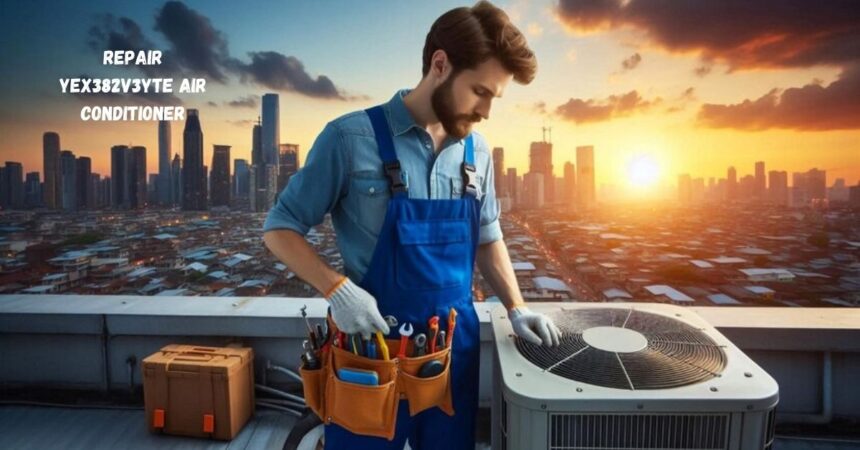Air conditioners are essential for maintaining comfort during hot weather. When your YEX382V3YTE air conditioner starts malfunctioning, it can disrupt your comfort and increase your energy bills. This guide will walk you through how to repair your YEX382V3YTE air conditioner to ensure it runs efficiently and keeps your home cool.
Common Issues with YEX382V3YTE Air Conditioners
Understanding the common issues that can occur with your YEX382V3YTE air conditioner can help you diagnose problems early and avoid costly repairs. Some of the most common problems include restricted airflow, refrigerant leaks, electrical issues, thermostat malfunctions, and strange noises.
Airflow problems can be caused by clogged filters, blocked ducts, or a malfunctioning blower motor. If the airflow is restricted, your air conditioner will not cool your home effectively and may work harder than necessary, leading to higher energy bills.
Refrigerant leaks are another common issue. If your air conditioner is not cooling properly, it could be due to a refrigerant leak. This not only reduces efficiency but can also harm the environment. Electrical issues such as faulty wiring, blown fuses, or a tripped circuit breaker can cause your air conditioner to stop working entirely.
Thermostat malfunctions can also cause problems. If your air conditioner runs constantly or not at all, the thermostat might be the issue. Finally, strange noises such as grinding, squealing, or rattling can indicate mechanical problems or loose components.
Step-by-Step Guide to Repairing Your YEX382V3YTE Air Conditioner
Now that you are aware of the common issues, let’s move on to the repair process. This step-by-step guide will help you troubleshoot and fix the most common problems with your YEX382V3YTE air conditioner.
Checking the Air Filter
The first step in repairing your air conditioner is to check the air filter. A clogged or dirty filter can restrict airflow, making your unit work harder and less efficiently. To check the filter, turn off the air conditioner and locate the filter compartment. This is usually found near the return air duct or the air handler. Remove the filter and inspect it for dirt or debris. If the filter is dirty, clean it with a vacuum or wash it with water. If it is heavily soiled or damaged, replace it with a new one. Reinsert the filter and turn the air conditioner back on.
Inspecting the Thermostat
Next, check the thermostat to ensure it is functioning correctly. Sometimes, a simple issue with the thermostat can cause your air conditioner to stop working. Make sure the thermostat is set to cool and the temperature is set lower than the current room temperature. Check the batteries in the thermostat and replace them if necessary. Clean the thermostat to remove any dust or debris that could interfere with its operation. If the thermostat is still not working, consider replacing it with a new one.
Examining the Electrical Components
Electrical issues are common in air conditioners, especially older units. To inspect the electrical components, turn off the power to the air conditioner at the circuit breaker. Open the access panel on the outdoor unit to expose the electrical components. Look for any loose or corroded wires and connections. Tighten or replace them as needed. Check the capacitor and contactor for signs of wear or damage. These components are responsible for starting the compressor and fan motor. If they appear damaged, replace them. Close the access panel and restore power to the unit.
Checking for Refrigerant Leaks
If your air conditioner is not cooling effectively, a refrigerant leak might be the issue. Refrigerant is the substance that cools the air in your home, and low levels can significantly reduce your air conditioner’s efficiency. Look for signs of a refrigerant leak, such as ice buildup on the refrigerant lines or hissing noises coming from the unit. If you suspect a leak, contact a professional HVAC technician to locate and repair the leak and recharge the refrigerant. Handling refrigerant requires special equipment and certification.
Inspecting the Evaporator and Condenser Coils
The evaporator and condenser coils play a crucial role in the cooling process. Over time, these coils can become dirty or damaged, reducing efficiency. To inspect and clean the coils, turn off the power to the air conditioner. Locate the evaporator coil inside the indoor unit and the condenser coil in the outdoor unit. Use a soft brush or vacuum to remove dust and debris from the coils. For stubborn dirt, use a coil cleaner specifically designed for air conditioner coils. If the coils are damaged, contact a professional for repair or replacement.
Maintenance Tips for YEX382V3YTE Air Conditioners
Regular maintenance is key to keeping your YEX382V3YTE air conditioner running smoothly. Here are some tips to help you maintain your unit.
Schedule regular inspections. Have your air conditioner inspected by a professional at least once a year. This will help identify potential issues before they become major problems.
Keep the area around the unit clear. Make sure the area around your outdoor unit is free of debris, plants, and other obstructions. This allows for proper airflow and prevents overheating.
Clean the coils regularly. Dirty coils can reduce efficiency and cause your unit to work harder. Clean them regularly to ensure optimal performance.
Change the filter frequently. A clean filter is essential for good airflow and efficient operation. Check the filter every month and replace it as needed.
Monitor the thermostat. Keep an eye on your thermostat settings and replace the batteries regularly to ensure accurate temperature control.
Conclusion
Repairing your YEX382V3YTE air conditioner may seem daunting, but with the right knowledge and tools, you can troubleshoot and fix common issues yourself. Regular maintenance is key to preventing problems and ensuring your air conditioner operates efficiently. However, for more complex issues like refrigerant leaks or electrical problems, it is best to consult a professional HVAC technician. By taking care of your air conditioner, you can enjoy a cool and comfortable home all summer long.
FAQs
How often should I clean the air filter?
It is recommended to check and clean the air filter every month, especially during the cooling season. Replace it every 3 months or sooner if it appears dirty.
What should I do if my air conditioner is leaking water?
Water leaks can be caused by a clogged drain line or a frozen evaporator coil. Check the drain line for blockages and ensure the evaporator coil is not frozen. If the issue persists, contact a professional.
Why is my air conditioner making a loud noise?
Loud noises can be caused by loose components, a malfunctioning fan motor, or debris in the unit. Turn off the air conditioner and inspect it for any visible issues. If you cannot identify the problem, call a technician.
Can I repair a refrigerant leak myself?
Repairing a refrigerant leak requires special tools and certification. It is best to leave this task to a licensed HVAC professional.
How can I improve the efficiency of my air conditioner?
Regular maintenance, such as cleaning the coils, replacing the filter, and scheduling annual inspections, can improve your air conditioner’s efficiency. Additionally, keeping your home well-insulated and sealing any air leaks can help.






